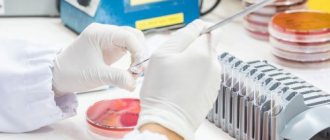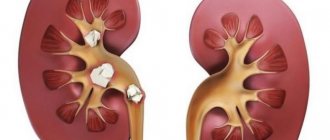HCG is human chorionic gonadotropin, which is a hormone produced by the fetus immediately after conception. Subsequently, the placenta is responsible for its reproduction. Therefore, the presence of a certain amount of this hormone in a woman’s blood or urine will clearly indicate that embryo implantation has occurred.
Two subunits are included in the structure of hCG - alpha and beta. Alpha is responsible for the production of other hormones and is not used to determine whether a woman is pregnant or not, so the beta subunit is used for this. If the pregnancy proceeds normally, then the beta subunit of hCG in the body of the expectant mother begins to appear approximately five to seven days after conception. A week after conception, the hCG concentration is more than 50 mIU/ml. The maximum level of hCG in urine is 200 mIU/ml (this indicator is observed in the first trimester of pregnancy).
It is important to note that tests of non-pregnant, completely healthy women may also contain hCG, but its level will be extremely low and insufficient to determine the presence of pregnancy. In addition, if the pregnancy is ectopic, the level of the gonadotropin hormone will be much lower, in contrast to a normal pregnancy.
The level of the hormone (carried out along with other common tests) is determined by doctors at approximately 15-20 weeks of pregnancy in order to identify the risks of fetal development abnormalities during the process of perinatal diagnosis. This is an extremely important analysis at these times, which allows you to obtain very effective research results that really help to detect in time all the deficiencies in the development of the fetus and take the necessary measures to eliminate them.
In some cases, hCG is used for diagnostic purposes as an oncological marker for the presence of malignant neoplasms of the trophoblastic tissue of the testes and ovaries, which are formed by human chorionic gonadotropin. This method is not used very often, but in a number of situations it is relevant.
What kind of hormone is this
This is a gonadotropic hormone that is produced by the cells of the chorion (dense membrane of the embryo).
A urine test for hCG is performed to determine whether conception has occurred. If not, the result will be from 0 to 5 units. If embryo implantation has occurred (that is, the fetus has attached to the wall of the uterus), then the level of the hormone will be increased. Analysis is also needed to understand how the fetus feels. A sharp decrease in hCG over several days may indicate an unfavorable course of pregnancy.
At its core, human chorionic gonadotropin is a type of gonadotropin that is necessary for the normal function of the placenta.
HCG is a protein conglomerate consisting of α- and β-units. The α-unit is not specific and is found in other gonadotropic hormones (that is, it can also be found in non-pregnant women). Studies are carried out to determine the β-unit, which is exclusively part of human chorionic gonadotropin.
HCG begins to be produced on the first day after embryonic implantation into the endometrium, that is, about a week after conception. When pregnancy occurs, the hormone maintains the function of the corpus luteum until the placenta forms. Under its influence, a larger amount of progesterone and estrogen hormones is formed.
HCG during pregnancy
HCG or human chorionic gonadotropin is a hormone that is secreted by the cells of the fetus after it attaches to the wall of the uterus and grows into the endometrium.
The production of hCG is an indicator in determining pregnancy in the earliest stages - almost immediately after conception. If this hormone is detected in a woman’s blood, this most likely indicates the presence of pregnancy.
But different levels of hCG levels can also indicate some pathologies in the body, and not just pregnancy. During pregnancy, the hormone chorionic gonadotropin promotes the preservation and subsequent normal development of pregnancy, and also prevents its termination.
Facts about HCG:
- If it were not for the presence of hCG, then endometrial rejection would occur, as happens in the normal menstrual cycle. That is, spotting would appear and the pregnancy would fail.
- HCG acts on the uterus and ovaries. This hormone is much stronger than a woman’s own hormones. HCG promotes the production of progesterone, which in turn is necessary for the normal maintenance of the uterus, in which a small fetus is now developing.
- The word “chorionic” means that the chorion is responsible for the production of the hormone, which is further converted into the placenta. Gonadotropin comes from the word gonads (maternal reproductive organs).
- The hormone acts on the mother's organs so that they are rebuilt differently in order to support the new life in a normal state.
- HCG can help a pregnant woman endure any stressful situations associated with pregnancy. The hormone also weakens the expectant mother’s immunity so that the body cannot reject the embryo. In addition, hCG acts on the gonads of the fetus.
We invite you to learn about additional tests during pregnancy from the video provided.
Factors of deviation from the norm
The results obtained during pregnancy may not meet the hCG standards in the table for various reasons.
When gonadotropin levels are higher than normal:
If the deadline is set incorrectly. In the first trimester, a difference of 5–6 days gives significant deviations
Therefore, you can compare the tabular data with your results, but you should understand that the hCG table during pregnancy is only a guideline and what is important is not the exact correspondence of the numbers, but the dynamics of their growth. With multiple pregnancy. Gonadotropin concentration is proportional to the number of embryos
So, for twins, the norm is multiplied by two, and for triplets, by three. After therapy with hormone-containing drugs based on gestagen. With toxicosis in the early period. With a genetic abnormality in the fetus.
In addition, the test result is affected by an increase in blood sugar.
When a low concentration of hCG is determined:
- If the deadline is set incorrectly.
- When the fetus develops outside the uterine cavity. The amount of the hormone increases, but at a reduced rate.
- If there is a threat of spontaneous abortion. The hCG level drops sharply by 40–50%.
- During a frozen pregnancy.
- With reduced blood supply to the placenta and insufficient nutrition.
Any deviation from the norm requires a retake to eliminate errors and additional examination methods.
Reduced hormone levels
A sudden decrease in the amount of hCG is also a danger to the health of the expectant mother and baby. There are several key reasons for this phenomenon:
- Improper development of placental tissue.
- Development of the fetus outside the uterine cavity. At the same time, the woman’s well-being seriously deteriorates, and a bloody secretion is released from the vagina. In such a situation, emergency hospitalization is necessary.
- Frozen pregnancy. The embryo suddenly stops growing. With such a problem, it is important to clean the uterine cavity as soon as possible. Otherwise, sepsis may develop, which is life-threatening for the woman.
Read more Tetracycline ointment against acne reviews
Constant monitoring of hCG on the days after ovulation will help to detect the threat of miscarriage in time. By taking adequate measures, you can save the baby.
What does low hCG mean?
Low gonadotropin levels in an expectant mother may indicate:
1. In the first trimester:
- ectopic pregnancy;
- genetic pathology of the fetus;
- frozen pregnancy;
- threat of stay, spontaneous abortion;
- intrauterine embryonic death.
2. In the later stages, it indicates a post-term pregnancy, requiring immediate stimulation of labor.
3. The lack of dynamics in the hCG analysis indicates hormonal problems in the mother’s body, the threat of miscarriage, and rejection of the embryo. Timely medication adjustment with drugs containing artificial “pregnancy hormone” is necessary.
If gonadotropin is low, an ultrasound is prescribed to confirm or refute the pathology.
Norm by week and by day
The results of urine tests for hCG and its content vary depending on the stage of pregnancy.
As can be seen from the table, the indicator drops from the 10th week of pregnancy, which is associated with the ongoing aging process of the chorionic villi. This decrease is called physiological.
For the most meticulous, there is also a table that displays the hormone level by day from ovulation.
The determination of hCG is of particular importance during ectopic pregnancy. In this case, the embryo is located in the fallopian tubes. The level of human chorionic gonadotropin is elevated in the first days, as in normal pregnancy. But it grows slowly, with a lag of 1-3 weeks. Therefore, if the dynamics of hCG growth is reduced, you need to undergo an ultrasound to rule out ectopic pregnancy.
How to carry out analysis correctly?
To obtain the correct result of the study, it is necessary to properly prepare for its conduct. To do this, you need to follow several key recommendations:
- Avoid eating fatty or overly spicy foods for several days before collecting samples. If possible, do not use medications. Avoid unnecessary stress and sex.
- Before collecting urine, prepare a small, clean and dry jar. The best option would be to use a special container for these purposes, which is sold today in any pharmacy. Toilet your genitals without using detergents.
- Only urine collected in the morning is suitable for analysis. It remains valid for 4 hours, so care must be taken to immediately deliver the biological fluid to the laboratory.
- First, you need to urinate a little in the toilet to drain the first portion of urine. Taking an average portion of urine will help eliminate errors in research.
If you contact a private laboratory to conduct such a study, you can get the result in 30 minutes. Due to the presence of long queues at public clinics, you will have to wait longer for the results of the examination.
Preparing for laboratory analysis
View gallery
An analysis for the determination of hCG in urine can be considered reliable if the following conditions were met before it was performed:
- refusal of sexual activity at least 12 hours before submitting the material to the laboratory;
- use of a sterile container to collect biomaterial;
- delivery of urine to the laboratory within 2 hours after its collection.
For analysis, it is necessary to collect an average portion of morning urine. Before this, it is necessary to carry out hygienic procedures and cover the vagina with a tampon. This will prevent secretions from getting into the urine. On the eve of the test, it is recommended to avoid eating foods that color the body fluid, such as beets.
Functions
The content of gonadotropin is relatively small, but it has a number of critical responsibilities on which the lives of interconnected organisms depend.
During the production of hCG, the following processes occur:
- Formation of the reproductive and endocrine glands of the fetus.
- Physiological preparation of a woman’s body for the upcoming birth.
- Preventing the disappearance of the temporary corpus luteum - a temporary gland that produces progesterone, necessary for the proper course of pregnancy.
- Suppression of further maturation of follicles, introducing them into a kind of inactive state while carrying a baby.
- Reducing the mother’s immune responses to prevent rejection of a partially foreign embryo in her body.
Fertilized egg attached to the wall of the uterus
What role does hCG play?
Human chorionic gonadotropin is a protein hormone with a complex chemical structure. It is especially important when hCG begins to be produced. Synthesis starts on the day the embryo attaches to the surface of the uterus. Therefore, an analysis for its presence in urine is carried out if pregnancy is suspected.
This hormone plays a big role in the body of the expectant mother. Among its main functions are:
- Slowing down the process of follicle maturation. They need to remain asleep during the entire period of bearing the baby.
- Launching active production of progesterone. Without this substance, the fertilized egg will not be able to attach to the wall of the uterus. Progesterone is also responsible for preparing the uterus to increase in size. It makes her looms more elastic, and therefore they stretch more easily.
- HCG is responsible for the formation of interstitial cells in the male fetus. Without them, a boy born in the future will not be able to have his own children.
- Suppresses the activity of the mother's immune system, thereby preventing fetal rejection. This is extremely important for Rhesus conflict.
- Participates in the construction of the placenta. Subsequently, it is in it that hormones are produced that help pregnancy proceed without deviations.
A urine test for hCG is certainly included in the complex of regular examinations of the expectant mother. Its deviation from normative values becomes a sign of pathology.
Laboratory methods for determining the hormone in urine
Tests for hCG are carried out if monitoring the dynamics of intrauterine development of the fetus is required, as well as if a tumor of the reproductive organs is suspected. Urine is also examined for gonadotropin if there are signs of a frozen pregnancy, and ultrasound does not detect the baby’s heartbeat. Indications for analysis are also the absence of menstruation. In addition, it is used to understand how well the induced abortion was performed.
The main method of laboratory testing of urine for hCG is the detection of the hormone using a specialized reagent. Based on its concentration, the specialist determines the gestational age. If it is higher or lower than normal and does not correspond to the deadline according to ultrasound, the patient is prescribed an additional examination. This is done in order to find out the reason for the deviation. Blood from a vein on an empty stomach is taken for analysis.
Valery Oslavsky: 'If a bone sticks out on your foot, take an ordinary 4%...'Read more »
Preparing for the test
In order for the results to be correct and correspond to the real clinical picture, it is necessary to prepare your body for the collection of biomaterial. Any violations in preparation may lead to a false result and repeated testing.
Women donating biomaterial are not allowed to:
- have sex the night before
- physically exert yourself (hard work, playing sports, etc.),
- drink alcohol and drugs, and smoke.
The biomaterial is collected in the morning in a sterile container. Morning urine contains slightly higher levels of hormones, which increases the likelihood of detecting hCG even in the early stages of pregnancy.
Normal hormone levels
A sensitive hCG hormone test will confirm pregnancy 7–9 days after conception. If your period has not started and the test remains negative, you should repeat it in a few days. Every day after conception, the level of hCG in the urine doubles, and closer to the 14th week it begins to rise rapidly.
The normal level of hCG in urine by day from conception is presented in the table:
HCG value in urine by days after fertilization
| Day after conception | Min. value in honey/ml | Wed. value in honey/ml | Max. value in honey/ml | Day after conception | Min. value in honey/ml | Wed. value in honey/ml | Max. value in honey/ml |
| 7 DPO | 2 | 4 | 10 | 25 DPO | 2400 | 6150 | 9800 |
| 8 DPO | 3 | 7 | 18 | 26 DPO | 4200 | 8160 | 15600 |
| 9 DPO | 5 | 11 | 21 | 27 DPO | 5400 | 10200 | 19500 |
| 10 DPO | 8 | 18 | 26 | 28 DPO | 7100 | 11300 | 27300 |
| 11 DPO | 11 | 28 | 45 | 29 DPO | 8800 | 13600 | 33000 |
| 12 DPO | 17 | 45 | 65 | 30 DPO | 10500 | 16500 | 40000 |
| 13 DPO | 22 | 73 | 105 | 31 DPO | 11500 | 19500 | 60000 |
| 14 DPO | 29 | 105 | 170 | 32 DPO | 12800 | 22600 | 63000 |
| 15 DPO | 39 | 160 | 270 | 33 DPO | 14000 | 24000 | 68000 |
| 16 DPO | 68 | 260 | 400 | 34 DPO | 15500 | 27200 | 7000 |
| 17 DPO | 120 | 410 | 580 | 35 DPO | 17000 | 31000 | 74000 |
| 18 DPO | 220 | 650 | 840 | 36 DPO | 19000 | 36000 | 78000 |
| 19 DPO | 370 | 980 | 1300 | 37 DPO | 20500 | 39500 | 83000 |
| 20 DPO | 520 | 1380 | 2000 | 38 DPO | 22000 | 45000 | 87000 |
| 21 DPO | 750 | 1960 | 3100 | 39 DPO | 23000 | 51000 | 93000 |
| 22 DPO | 1050 | 2680 | 4900 | 40 DPO | 25000 | 58000 | 108000 |
| 23 DPO | 1400 | 3550 | 6200 | 41 DPO | 26500 | 62000 | 117000 |
| 24 DPO | 1830 | 4650 | 7800 | 42 DPO | 28000 | 65000 | 128000 |
There are also hCG norms for each week of pregnancy. It is through them that the process of child development in the womb is controlled.
The average concentration of HCG in urine by week of pregnancy is presented in the table:
Average hCG values in urine by week of pregnancy
| Week of pregnancy | HCG norm in honey/ml |
| 1–2 | 10-170 |
| 2-3 | 105-3100 |
| 3-4 | 1960-27300 |
| 4-5 | 11300-74000 |
| 5-6 | 31000–128000 |
| 6-7 | 27500–237000 |
| 7-11 | 21000–300000 |
| 11-16 | 15000–60000 |
| 16-21 | 10000–35000 |
| 21-38 | 10000–60000 |
In a non-pregnant woman, the amount of the hormone should be no more than 5 mU/ml. If the hCG content is higher than this value, it is necessary to re-test in a few days. Decoding the results will help you understand whether fertilization has occurred or not.
Normal levels of human chorionic gonadotropin
After the process of fertilization of the egg has occurred, the active release of gonadotropin begins. In the first trimester of pregnancy, its value reaches 2 times higher than normal, this is due to the fact that its value increases every 2 days. When the 7th week of pregnancy occurs, this indicator is at its peak, and then does not change until the 2nd trimester. It is based on this indicator that doctors make a conclusion whether the pregnancy is proceeding normally or not.
At weeks 14 and 18, the level of such a hormone can signal the development of a pathological process. Therefore, they may prescribe such an analysis again to be on the safe side. Typically, women are prescribed hCG at 9 DPO, hCG at 11 DPO, and hCG at 14 DPO.
We can say that this indicator is relative and each laboratory has its own. The approximate values of this indicator are as follows:
- 8 DPO – 17-134 mIU/ml;
- 10 DPO – 17-147 mIU/ml;
- 12 DPO – 24-199 mIU/ml;
- 13 DPO – 29-213 mIU/ml;
- 14 DPO – 33-223 mIU/ml;
- 15 DPO – 33-429 mIU/ml;
- 16 DPO – 70-758 mIU/ml;
- 17 DPO – 111-514 mIU/ml;
- 18 DPO – 135-1690 mIU/ml;
- 19 DPO – 324-4130 mIU/ml;
- 20 DPO – 385-3279 mIU/ml;
- 21 DPO – 506-4660 mIU/ml.
If your indicator is higher or lower than normal, this is not always a reason to panic. After all, such data may indicate the development of pathologies or the onset of serious problems in a woman’s body. The main thing is that before you panic, you need to clarify that the pregnancy period is set correctly.
Too high an indicator indicates the development of a multiple pregnancy; usually the level of the hormone in the blood increases in proportion to the number of embryos. This means the presence of problems such as toxicosis, gestosis, fetal abnormalities and post-term pregnancy. We must not forget that the increased value will be if the expectant mother suffers from diabetes or takes synthetic gestagens.
There is also such a thing as a false positive result. If, based on the results of the study, it turns out that the woman is not pregnant, and the hCG level is high, then its value was influenced by one of the following factors:
- If the woman was taking hormonal medications, including birth control pills.
- A residual phenomenon after an abortion or previous pregnancy.
- Bubble drift.
- Development of tumors of the ovaries, uterus, kidneys and lungs.
A reduced rate indicates an ectopic pregnancy, a threat of miscarriage or post-maturity. This reduced rate also occurs during placental insufficiency.
Human chorionic gonadotropin during a frozen pregnancy also has low levels. At this moment, the hormone is not produced and it falls. Usually, to diagnose this condition, the doctor performs several types of tests in a row, and then makes a conclusion based on them.
Sometimes the indicator goes beyond the limits as a result of the fact that the gestational age was set incorrectly. That is why doctors refer the patient for an ultrasound examination to clarify, where they make a final conclusion.
But there are cases when the fetus has frozen, and the level of this hormone increases. A negative value of this hormone can also be established; in such a situation, the analysis is repeated.
Deviations from the norm, possible causes
Increased or low saturation of human chorionic gonadotropin is a sure sign of the presence of pathology in the body.
Level increased:
- More than one fetus develops (twins, triplets). The amount of hCG up to 5-6 weeks during a singleton pregnancy doubles every 24 hours; during a multiple pregnancy, the concentration of the hormone is multiplied by the number of embryos in the womb.
- The woman suffers from dangerous diseases - histosis, diabetes mellitus. With histosis, swelling and late toxicosis occur. This can lead to placental abruption, fetal hypoxia, and fetal death.
- The fetus develops with abnormalities.
- The woman has reached menopause and has kidney pathologies. Due to sudden jumps and disruption of the functions of removing the hormone from the body, the concentration can exceed the norm tens of times.
- The woman takes hormonal medications. At the time of taking the test, it is advisable to stop taking the medications.
- Elevated levels in men and non-pregnant women warn of cancer. Early and timely diagnosis will help to begin treatment and tumor removal as early as possible.
Level down:
- An ectopic pregnancy develops. If, when determining conception with an express test, the second strip becomes paler with each diagnosis, there is discharge with blood, poor health, immediate hospitalization, ultrasound examination and emergency termination are necessary. Unfortunately, surgery leads to the removal of the tube where the fetus was attached, which reduces the likelihood of a new pregnancy.
- The placenta is underdeveloped. The fetus in the womb is nourished by the placenta, so placental insufficiency directly affects the development of the embryo.
- “Frozen” pregnancy, there is a threat of miscarriage. To prevent fetal death, strict medical supervision and hospitalization are required.
A reliable way to determine human chorionic gonadotropin is a blood test. If the urine test does not provide clear information and raises doubts, it is necessary to donate blood on an empty stomach in the laboratory. As a rule, results can be obtained within a few hours. Self-diagnosis and interpretation of analysis is strictly prohibited. Recommendations for deciphering the analysis and treatment are given only by a competent doctor.
https://youtube.com/watch?v=6vFXYKu1l7s
Diagnostics
A woman who does not know the scientific definition of hCG, one way or another, encounters its principle using an express test to determine pregnancy. It is based on immunochromatographic analysis - a quick method for determining the concentration of a substance using indicator strips.
The principle is based on the movement of liquid when a test strip is immersed in it. The test hormone that binds to the dye, if present in the liquid, begins to appear on the test strip.
That is, if the menstrual cycle is delayed, in order to confirm the fact of conception, it is necessary to lower the test strip into the container with the urine being tested to the desired level. The results are assessed in a couple of minutes. Two colored stripes – there is pregnancy, one colored stripe – there is no pregnancy.
For a more accurate determination of hCG, it is better to take morning urine with the highest concentration. A negative test may also indicate an ectopic pregnancy, or the test may simply be done too early. For reliability, it is better to stock up on several express strips.
The important discovery of hCG makes it possible to diagnose pregnancy and, if unwanted, terminate it at the earliest stages.
Read more Pustules appear on the body
In men and non-pregnant women, the human chorionic gonadotropin value is in the range of 0-5 mU/ml .
How the analysis is carried out
The analysis can be done in some paid laboratories. To do this, collect the very first urine in the morning in a sterile jar or container. To eliminate errors, an average portion of urine is needed. If collected incorrectly, errors may occur. Therefore, gynecologists combine analysis of hCG in urine with additional research methods (for example, gynecological examination).
Be careful: it is impossible to determine pregnancy using a general urinalysis (UCA)! You need to order an hCG test from the laboratory.
Human chorionic gonadotropin is detected in the urine in a woman’s body 7-10 days after conception. A more accurate and reliable result can be obtained from the first day of the delay.
Express laboratories will give you an answer within two hours. The duration of the study itself is only about 30 minutes. The essence of the method is to determine the β-unit in urine using specific markers. The concentration of the hormone is proportional to the color of the test sample. The accuracy of the method is 98-99%. This method allows you to determine not only the presence of the hormone, but also its amount produced in the human body.
Keep in mind that a blood test for human chorionic gonadotropin is used to more accurately determine the concentration. Fluctuations in the level of hCG in the blood occur much faster than in the urine.
How does the second stripe appear?
All pregnancy tests, regardless of manufacturer and cost, work the same. A special reagent applied to the strip is colored only when a sufficient amount of a hormone is detected in a woman’s urine, which is a faithful companion to bearing a child - human chorionic gonadotropin, which in various medical documents is abbreviated as FSHA, GPHa, LHA, TSHA, hCG or HCG .
This substance is often present in the analyzes of non-pregnant women, and even men, but in very small quantities. If a cherished event takes place and a child is conceived, HCG begins to be produced more actively. It is produced by chorion cells. Gonadotropin is necessary for the female body in order for pregnancy to develop.
Under its influence, the corpus luteum formed after ovulation does not disappear, as happens in the absence of pregnancy before menstruation, but remains for the first few months. It takes on the function of the main endocrine organ for the developing embryo.
Under the influence of human chorionic gonadotropin hormone, a woman’s immunity is somewhat weakened, which increases the chances of the embryo surviving.
Otherwise, the mother’s strong and well-trained immunity would simply reject the baby, because he is half foreign, since he contains the father’s genetic material.
The production of hCG in a woman’s body gives the start command for the active production of progesterone, without which preserving and bearing a child will be impossible, as well as the female sex hormone estrogen, which is also extremely important during pregnancy.
The level of the hormone increases at a rapid pace, starting from the moment of implantation.
Within a few hours after meeting the sperm, the fertilized egg begins its journey into the uterine cavity. She has to pass through the fallopian tube, descend into the uterine space and gain a foothold in the wall of the main reproductive female organ.
This moment is called implantation. Sometimes a woman can guess about it herself - by slight tugging sensations in the lower abdomen, by a drop of spotting on a panty liner. Implantation usually occurs 6-10 days after fertilization.
Most often - on the eighth day.
From this moment, the chorion triggers the production of gonadotopin, and the amount of the hormone gradually increases, almost doubling every 48 hours. This does not mean that the substance can immediately be found in the woman’s blood or urine.
A certain time must pass for the amount of HCG to exceed the sensitivity thresholds of tests from the pharmacy and laboratory reagents.
Increasing and decreasing indicators
Diagnosing the level of this hormone is very important. The indicator determines the exact gestational age
If the pregnancy is multiple, then hCG is increased as many times as the number of embryos developing inside the uterus.
If there is an abnormal increase in human chorionic gonadotropin in the blood (if the indicator does not correspond to the gestational age), various options are possible:
- The gestational age is incorrect.
- Preeclampsia (late toxicosis) develops or diabetes mellitus is present.
- Defects and hereditary diseases of the embryo.
- When using synthetic hormones.
- Frozen pregnancy.
- Ectopic pregnancy.
- Dysfunction of the placenta.
- Risk of miscarriage.
- Post-term pregnancy.
- Developmental delay or fetal death.
If the indicator is initially small, then most likely the pregnancy is ectopic, which can threaten the woman’s life and requires urgent medical intervention.
HCG in the blood can appear not only in pregnant women, but also in non-pregnant women and men.
- For medicinal purposes, medications containing hCG are taken.
- Testicular tumors.
- Tumors of the uterus.
- Neoplasms in the kidneys, lungs and gastrointestinal tract.
If the indicator shows a deviation from the established norm within a given period, then this is not very good
Both an increase and a decrease in human chorionic gonadotropin indicate complications, but it is important to know the exact period so as not to be mistaken with the conclusions
Elevated hormone levels may indicate the following abnormalities and features:
- Diabetes.
- Menopause.
- A woman's use of hormonal drugs.
- Renal dysfunction.
- Chromosomal abnormalities in the developing child.
- Histosis.
- Bubble drift.
Elevated hCG in non-pregnant women and men most often signals a malignant tumor.
A reduced level of gonadotropin, in turn, is an indicator of such physiological disorders as:
- Underdeveloped placental tissue.
- Risk of miscarriage.
- Ectopic pregnancy.
- Frozen pregnancy.
A multiple increase in the amount of hormone produced is also observed during multiple pregnancies.
What does increased hCG mean compared to normal?
A sharp increase in hCG in urine samples and in the blood is a consequence of the following problems:
- Impaired kidney function.
- Diabetes.
- Use of hormonal drugs.
- Preeclampsia is a complicated course of the third trimester of pregnancy. Accompanied by deterioration of health and severe swelling.
- Elevated levels of the hormone often indicate abnormalities in the chromosome complement of the developing fetus.
- Hydatidiform mole - pathological changes in the chorion. It is often accompanied by spontaneous bleeding, an unnatural increase in the size of the uterus, and bouts of vomiting.
- Formation of malignant tumors.
If, when studying hCG by days from conception, a sharp jump in the indicator was noticed, this does not always indicate a disease. Sometimes this symptom is accompanied by multiple pregnancies. An ultrasound scan will help identify it.
When can you get tested for hCG?
It is better to take an hCG test starting from the first day of the delay or no earlier than 14 days after the expected conception. Otherwise, it may be wrong:
| day after conception (ovulation) | Min. | Avg. | Max. |
| 10 DPO | 8 | 18 | 26 |
| 11 dpo | 11 | 28 | 45 |
| 12 dpo | 17 | 45 | 65 |
| 13 dpo | 22 | 73 | 105 |
| 14 dpo | 29 | 105 | 170 |
| 15 dpo | 39 | 160 | 270 |
| 16 dpo | 68 | 260 | 400 |
| 17 dpo | 120 | 410 | 580 |
| Continuation of the table - see “HCG level by days from conception” |
The hCG calculator will help you decipher the analysis results:
Note:
1. HCG norms are given for the period of pregnancy “from conception (ovulation)”, and not according to the date of the last menstruation.
2. The above figures are not a standard! Each laboratory may have its own standards. When assessing the results, it is advisable to rely on the standards of the laboratory where you were analyzed!
3. If you don’t know your gestational age or test results don’t match your calculations, take a look at our pregnancy calendar. Perhaps you simply calculated it incorrectly.
Why is a test prescribed if pregnancy is confirmed?
For dynamic monitoring of the course of pregnancy, sometimes (most often in hospital settings) a hCG analysis in urine is prescribed on a daily basis. At the same time, changes in the hormonal levels of pregnant women under the influence of treatment can be observed. The concentration of hCG determines whether therapy with hormonal drugs can be continued. When normal hormone levels are reached, the dose of hormonal agents used in treatment is gradually reduced.
Sometimes hCG studies by day from conception are often carried out to determine the degree of embryo implantation during in vitro fertilization (IVF).
According to indications, laboratory tests are prescribed in the following cases:
- confirmation of pregnancy;
- monitoring pregnancy throughout its entire duration;
- threatened termination of pregnancy;
- suspicion of a hormone-producing neoplasm.
In some cases, determining the exact concentration of the hormone allows you to find out the expected due date.
Change in hCG level
In the first weeks of pregnancy, its level doubles approximately every 2-3 days. An increase in hCG levels by 60% in two days is also considered normal. When the level reaches 1200 mU/ml, hCG doubles every 3-4 days (from 72 to 96 hours). After 6000 mU/ml, doubling occurs on average every 4 days (96 hours).
As pregnancy progresses, the rate of increase in hCG levels decreases:
up to 1200 – from 30 to 72 hours1200–6000 – from 72 to 96 hoursmore than 6000 – more than 96 hours
During multiple pregnancies, the hCG content increases several times faster - in proportion to the number of fetuses.
At 8-9 obstetric weeks of pregnancy (6-7 weeks from conception), hCG stops rising and begins to slowly decline.
Reduced concentrations of hCG may indicate a later onset of pregnancy (with normal growth dynamics), an ectopic pregnancy, or a threat of miscarriage.
How does it affect pregnancy?
During the formation of the placenta, chorionic gonadotropin improves its nutrition, increases elasticity and initiates the growth of chorionic villi. The influence of the hormone has a beneficial effect on the course of pregnancy and contributes to its preservation.
Read more Menses are smeared with black color
In the days after ovulation, human chorionic gonadotropin begins to grow exponentially. An increase in level is observed until the second trimester of pregnancy. In the second and third trimesters, the concentration of hCG in the urine gradually decreases to maintenance values.
In general, the level of human chorionic gonadotropin shows the degree of chorionic influence on the entire body. Studies have shown that hCG increases the production of glucocorticoids by the adrenal cortex. An increased amount of steroid hormones improves the adaptive capabilities of a pregnant woman. Glucocorticoids also have a physiological immunorepressive effect, which is also aimed at preserving the placental barrier.
Tests for detecting hCG at home
It is not at all necessary to take tests to the laboratory to confirm or deny pregnancy. You can also do the test at home; pharmacy chains offer a wide range of tests for this purpose. They differ in sensitivity to the hormone, as well as in the method of use.
Sometimes it happens that the test is positive, but the laboratory test for hCG is negative. This happens due to poor quality of the test or problems in the child's development.
Types of Pregnancy Tests
It is recommended to do a hCG test no earlier than the 5th day of missed menstruation. During this period, there is a sharp increase in the concentration of the hormone, therefore the reliability of the results is high.
The tests have one control strip, which becomes colored in any case. The second strip appears only if the hormone is present in the urine.
There are several types of tests:
- The test strip is the simplest option on the market. Due to its low cost and ease of use, it is the most popular. The strips are usually individually packaged, each with a control zone coated with a gonadotropin-sensitive reagent. The analysis takes only a few minutes. The strip is dipped into morning urine until a certain mark is reached and after 5 minutes the result is observed.
- Tablets have higher sensitivity and are much more expensive. Such rapid tests can detect pregnancy much earlier. The tablet itself consists of a plastic case and a hole with material impregnated with a reagent. Urine is applied into this hole using a pipette.
- Inkjet - easy to use and highly sensitive. To get the result, simply place the test rod under a stream of urine. Due to the high content of the reagent, it makes it possible to carry out it at very early stages.
- Systems with reservoirs - have a special container for collecting biomaterial. The only difference with previous tests is that they are convenient to use.
- Electronic tests of a new generation. Thanks to the latest technologies, they not only detect the hormone, but also determine its concentration. The test is equipped with a small electronic display that will show the gestational age. The only drawback is the high cost.
To ensure the accuracy of the test result, it is worth buying several options from different manufacturers. This will help you get an objective assessment. If after a negative test your period still does not begin, you should consult a gynecologist for advice.
The presence of the hormone in the urine is the first sign that a woman is pregnant. Based on the concentration of hCG, you can calculate the approximate day of conception even without an ultrasound. But the presence of the hormone does not always mean pregnancy; its appearance can be a consequence of many problems in the body, including malignant tumors. There is nothing complicated or confusing about performing the test at home. Due to its availability and the availability of different options, every woman can determine pregnancy using the hCG test. Oslavsky: 'A protruding bone on the leg is afraid of this like fire! Take 4%...'
How to properly prepare for blood sampling?
To test for hCG, a venous blood sample is required - both for general analysis and for analysis of beta elements. The rules for preparing for it are standard:
- The test is taken in the morning and must be done on an empty stomach. From the last snack - at least 8-12 hours.
- Be sure to tell the specialist before taking a blood sample about the medications you are taking. As a rule, only products containing hormones contribute to fixing a false level of human chorionic gonadotropin. In particular, they can be taken by a woman to stimulate ovulation (with diagnosed infertility). Other medications, according to experts, do not affect the results.
Knowing when hCG will indicate pregnancy, it is better to submit the material for laboratory analysis on the 4-5th day of your absence of menstruation. To clarify, it is worth repeating it after 2-3 days. The next blood test for hCG is carried out already in the 2nd trimester - to identify pathogenic abnormalities in the fetus.
Self-administered test
The presence of hCG during pregnancy can be easily detected using special tests. They are sold everywhere in pharmacies. Their range today is huge. They differ in the level of sensitivity, as well as in the method of application. There are several key types of such indicators:
- Test strip. One of the oldest and simplest types. It is popular among women due to its low cost. Each strip is packed in a sealed bag. It must be used immediately after opening. The strip is equipped with a control zone soaked in the reagent. It needs to be dipped in urine and wait a few minutes. Upon contact with human chorionic gonadotropin, two stripes appear on the test. This will indicate pregnancy.
- Jet test. It is characterized by increased accuracy. It is used even in the early stages of pregnancy. One part of this dough is a small rod. It must be placed under the stream at the time of urination. In a couple of minutes you will be able to evaluate the result.
- Tablets. They are quite expensive. At the same time, the price-quality ratio is in favor of the consumer. The test has a plastic case in which a special window is located. Using a pipette, urine should be poured into it.
- Reservoir. Equipped with a special container. Pee directly into it. There is no need to collect urine or use other devices. If after a few seconds of waiting two stripes appear, then pregnancy has occurred.
- Electronic. They appeared on the domestic market recently. Suitable for people who want to immediately find out the duration of pregnancy. The design of the test allows one to detect the content of hCG in urine and simultaneously determine its concentration.
To obtain an accurate result, experts recommend using several tests of different types simultaneously. If they show an ambiguous result, for example, the second strip is too pale, then it is better to contact the institution and take full urine and blood tests. You need to do the test immediately after waking up; during the day, the results may be subject to large errors.
The hCG test will have to be taken weekly. This will allow the expectant mother to avoid health problems and be confident in the well-being of the baby. When the examination reveals a difference with standard indicators, do not immediately be alarmed. You will have to undergo a full examination at the clinic to determine the exact cause of what happened.
"Ghost" stripe
A negative test at 13 DPO can also occur during pregnancy. It’s just that the level of the hCG hormone is not yet sufficient for the reagent to react and clearly show the second strip. But at the same time, some women see a pale line on tests. This result also cannot be considered reliable. The test needs to be repeated in a couple of days.
The line of evaporation is also called a “ghost” stripe, when there was a colored mark, but after a while it became completely invisible. The Phantom has the same width and length as the control sample. It is colored blue, pink or lilac, but is paler and barely noticeable. In some ways, the “ghost” resembles a smoky trail where there should be a brightly colored second stripe.
When should the research be carried out?
An increase in hCG during early pregnancy is observed every 2-3 days. After fertilization, 6-7 days must pass before the embryo is securely fixed in the uterus. You can donate blood for analysis 10 days after pregnancy. Express tests show a positive result after 2 weeks: this is due to the lack of sensitivity of the reagents to hCG. In urine, the concentration of the hormone may increase more slowly than in the blood.
HCG readings (in dynamics), different from the norm, also indicate the development of several embryos in the womb at once. Venous blood is examined in laboratory conditions. The most accurate results can be obtained 2 weeks after fertilization. In women, late implantation occurs (when the fetus is fixed in the uterus for a long time), so even with negative indicators, you need to donate blood again after 5-7 days.
At 5 obstetric weeks, the fetus may die due to anatomical uterine abnormalities. The embryo freezes due to lack of opportunity to develop normally in the womb. If the level of hCG at the 5th week of pregnancy has increased 3 times or more, then the woman needs to be checked for the presence of trophoblastic tumors.
Tests cannot be neglected: blood must be tested for hCG regularly in order to recognize a frozen pregnancy in time. In this case, the embryo dies without spontaneous abortion occurring. During a frozen pregnancy, the rate stops doubling. The diagnosis can be confirmed using an ultrasound: the fetal heartbeat cannot be heard or the fertilized egg cannot be seen.
If the fetus froze in the last trimester of pregnancy, then the deviation from the hCG norm in terms of timing is most often insignificant. The pathology is called antenatal pregnancy. With anembryony, the fetus freezes at 5 weeks. In this case, hCG stops increasing and its levels remain the same for several days. With chromosomal abnormalities, the embryo most often dies at 12 weeks.
How does the hormone level increase?
In women before pregnancy, the level of the hormone in the body does not exceed values in the range from 0 to 5 mU/ml. And the substance is not detected in urine at all. If conception has taken place, then for the first time the hormone level will exceed the “non-pregnant” threshold only on the second or third day after implantation. It must be said that all women produce the hormone at different rates, and therefore you should not demand mathematical accuracy from laboratory technicians.
By the way, these morally difficult days are called by ladies dreaming of motherhood with the abbreviation DPO, which means “day after ovulation.” Ovulation, of course, is also not fixed for everyone, but in the vast majority of cases it falls on the 14-15th day of the cycle - at its very middle with a menstrual cycle lasting 28 days. Thus, 2 DPO is two days after ovulation or the 17th day of the cycle, and 5 DPO is the 20th day from the start of the menstrual cycle and only the fifth day after expected ovulation.
If the second phase of the female cycle lasts 14 days, then the first day of the delay is considered to be 14 DPO or 29 days of the cycle.
Many women, waiting for good news, begin testing too early and are very worried about the lack of the treasured second line. How many days after conception can you safely do a test for hCG, it becomes clear if you know how the quantitative indicator of the hormonal substance in the blood changes.
Table of average quantitative values of HCG in the blood during pregnancy:
| Time since ovulation | Average HCG concentration | Lowest HCG value | Highest HCG value |
| 15 DPO (start of delay) | |||
| 28 DPO (two weeks late) |
Test sensitivity
The gonadotrope produced from the moment of attachment of the fertilized egg first enters the blood, and only then part of it is excreted in the urine. Therefore, at the initial stage, even before the delay occurs, only a biochemical blood test can show the “piquant situation”.
The tests, which are available at any pharmacy or store, also differ in their sensitivity, in their ability to “catch” traces of the hormone in the secreted liquid. The minimum is 30 units, the maximum is 10. Most often on pharmacy shelves you can find test strips with an average sensitivity of 20-25 mU/ml. They are able to respond with a control strip to an increase in human chorionic gonadotrope only 14-15 days after conception. That is why they are recommended to be carried out in the first days of the actual delay, so that the results are not in doubt.
If ovulation occurred on time and implantation was not delayed, then the analysis will give informative first results at least 10-11 days after fertilization.
Of course, it happens that the test begins to show a weak second line even earlier, but this becomes possible only in women with hCG production at the maximum level or above the average norm. There is only one conclusion from all of the above - if about as early as possible, you should go to the nearest clinic to donate blood for hCG determination.
If “time is of the essence,” then the woman should be patient, not be nervous and wait for the delay in order to conduct a simple and understandable home test, which with a high degree of probability will be able to answer the main question 2 weeks from conception.
conclusions
Blood test for hCG - what is it? It turns out to be a standard and very informative analysis. With its help, you can accurately diagnose pregnancy within 2 weeks after conception.
HCG is a specific hormone produced by the tissues of the chorion (later the placenta). After implantation of the embryo into the uterine cavity, its quantity increases sharply, stimulating the restructuring of the body to bear the fetus.
HCG indicators characterize pregnancy in the best possible way and promptly notify the expectant mother not only about the “interesting” situation, but also about disruptions in the baby’s development.











